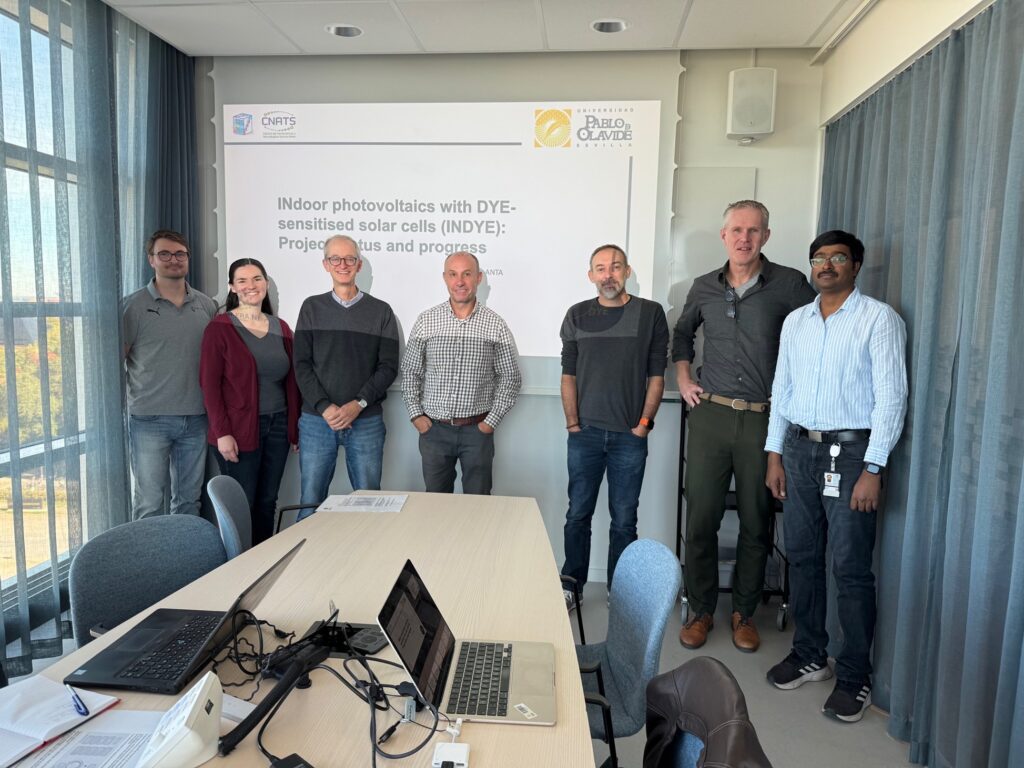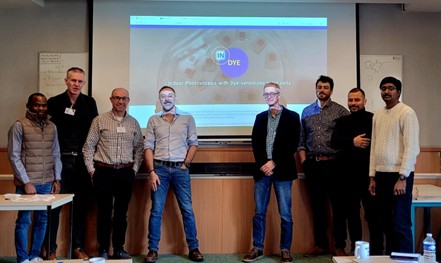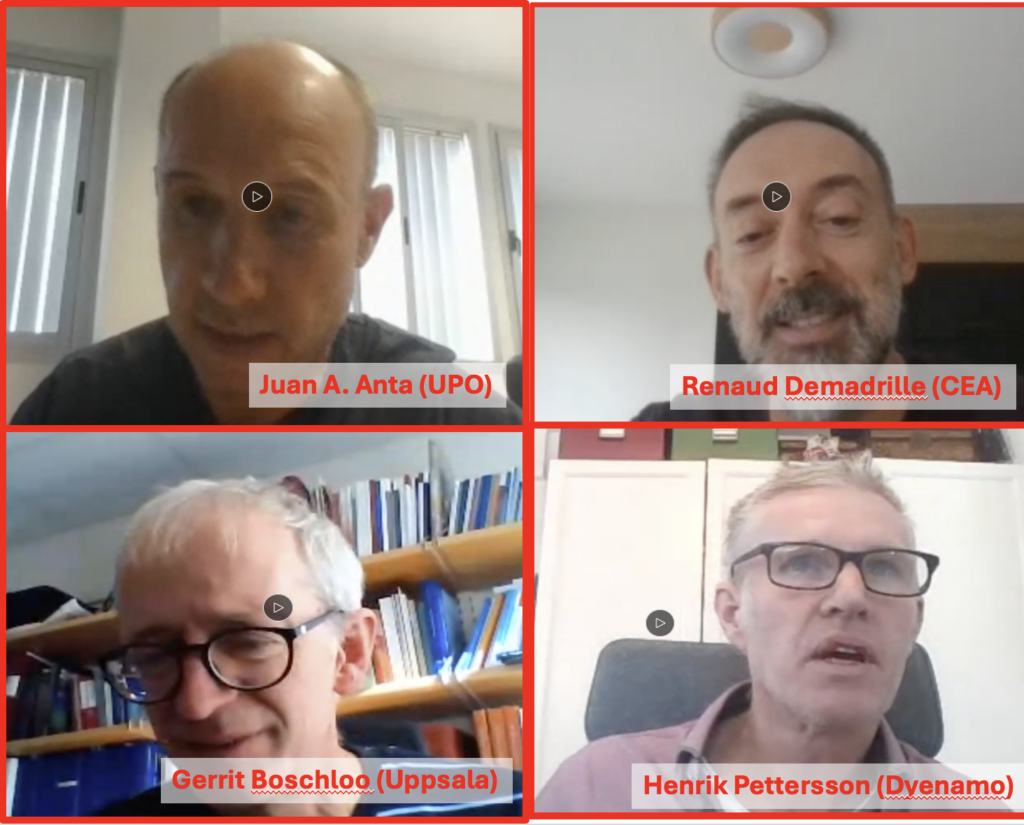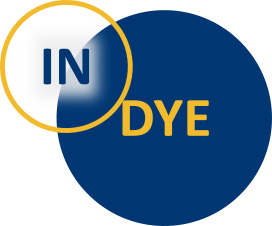News
Publications
Data-driven modelling for electrolyte optimisation in dye-sensitised solar cells and photochromic solar cells
Mater. Horiz., 2025, Advance Article
Johan Liotier, Antonio J. Riquelme, Valid M. Mwalukuku, Quentin Huaulmé, Yann Kervella, Renaud Demadrille and Cyril Aumaître
Abstract
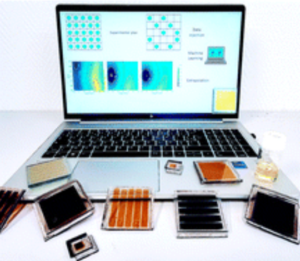
Because they can be made semi-transparent, dye-sensitised solar cells (DSSCs) have great potential for glazing applications. Their photovoltaic performance and light transmission depend not only on the dye used, but also on the electrolyte they contain. A few years ago, we introduced the concept of solar cells with dynamic optical properties based on the use of photochromic photosensitizers. These cells allow variable light transmission according to sunlight conditions, while producing electrical energy. We found that the electrolytes commonly used in DSSCs are not optimal for this class of photosensitisers and need to be tuned. In this work, we have developed and characterised two new photochromic dyes for use in solar cells and we present a study aimed at developing electrolytes specifically adapted to these dyes. Using a methodology based on the design of experiments (DoE) combined with a machine learning (ML) approach, we show that it is possible to quickly find an optimal formulation for iodine-based electrolytes to achieve good transparency of photochromic devices with an AVT ranging from 57% to 23% across the photochromic process, while keeping the photovoltaic conversion efficiency above 2.9%. We show that this approach can be applied to other classes of electrolytes with different redox systems, such as TEMPO/TEMPO+. After optimisation, TEMPO-based electrolytes yielded photochromic semi-transparent solar cells with a PCE of up to 2.16% and an AVT varying between 55% and 13% and opaque photochromic cells with a PCE of 3.46%. Finally, this new TEMPO-based electrolyte was tested with a non-photochromic dye and gave a PCE of up to 7.64%, which is probably the highest performance to date for a dye solar cell using a pure TEMPO/TEMPO+ redox system.
Competition between Transport and Recombination in Dye Solar Cells at Low Light Intensity
Solar RRL, 2024, Volume 8, Issue 10, 2400149
Patricia Sánchez-Fernández, Clara A. Aranda, Renán Escalante, Antonio J. Riquelme, Renaud Demadrille, Paul Pistor, Gerko Oskam, Juan A. Anta
Abstract
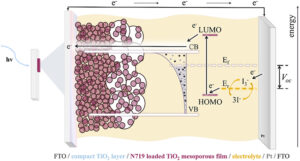
The efficiency of electron collection in a dye-sensitized solar cell (DSC) is determined by a delicate balance between electronic transport and recombination losses caused by electron transfer to dye cations and electron acceptors. While state-of-the-art DSCs have demonstrated quantitative electron collection under standard 1 sun conditions, the nonlinear nature of the trapping/detrapping dynamics in the photoanode with respect to the stored electronic charge can result in suboptimal performance under the low illumination intensity conditions commonly found indoors. Herein, the key factors influencing electron collection in relation to light intensity using impedance spectroscopy and numerical analysis are thoroughly examined. Impedance analysis reveals that the electron diffusion length tends to decrease as the quasi-Fermi level is lowered, approaching the critical limit (Ln/d ≈ 1) at intensities characteristic of indoor illumination. A range of tert-butyl pyridine concentrations and different thermal and chemical treatments of the TiO2 are tested, showing that this low intensity limitation is inherent to the multiple-trapping mechanism that governs the functioning of a DSC. It is concluded that relatively high ideality factors, nonoptimal electrolyte compositions, or small variations in the quality of the TiO2 layer can result in electron collection limitations that are not apparent under 1 sun but become noticeable at low light intensities.
Strategies to Improve the Photochromic Properties and Photovoltaic Performances of Naphthopyran Dyes in Dye-Sensitized Solar Cells
Advanced Energy Materials, 2023, Volume 13, Issue 8, 2203651
Valid M. Mwalukuku, Johan Liotier, Antonio J. Riquelme, Yann Kervella, Quentin Huaulmé, Alix Haurez, Stéphanie Narbey, Juan Antonio Anta, Renaud Demadrille
Abstract
Semi-transparent solar cells are emerging as promising devices for building integrated photovoltaics. However, regardless of the technology considered, the optical transmission of semi-transparent solar cells is fixed during the fabrication process, and hence, cannot adjust to variations in daylight or weather conditions. This becomes an issue when applications such as photovoltaic windows are envisioned. Previously, it has been reported that the use of photochromic naphthopyran dyes in dye-sensitized solar cells (DSSC) allows for the fabrication of semi-transparent devices capable of modulating their light transmission and energy production depending on light intensity. Herein, a series of naphthopyran dyes with an identical pi-conjugated backbone and varying alkyl substituents is reported. Using this molecular engineering strategy, the control of the discoloration kinetics of the photochromic dyes and the reduction of undesirable recombination processes when utilised in solar cells is demonstrated. The clear photochromic-photovoltaic structure-property relationships for these new photosensitizers is established and they are shown to demonstrate improved photovoltaic performances and photochromic responses in DSSC with notably faster discoloration than previously reported. For the first time with photochromic molecules, the co-sensitization of the electrodes is explored and the highest power conversion efficiency for a photochromic DSSC is reported, reaching up to 4.34% under standard conditions.

